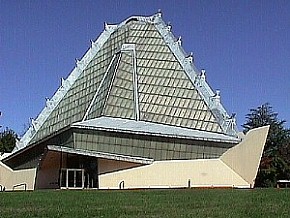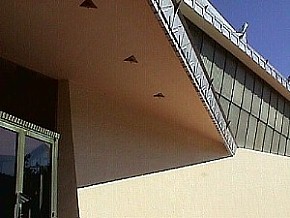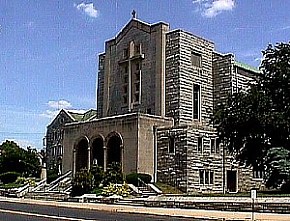2009.08.29 21:59
fashion tip (of the iceberg)
I was wondering, what's the most expensive building on the planet right now?
2009.08.29 13:04
Shared birthdays (?)
publication of Einstein's General Theory of Relativity
2009.08.26 17:19
Postmodernism sucks... discuss
"In the future, all architecture will be post-modern for fifteen minutes."

OR

"What the hell's wrong with you?! Never seen a green architect before?"
| |
2009.08.19 15:18
Postmodernism sucks... discuss
Purist perhaps in the sense that I'm most interested in the source material that's available.
Regarding S. Sophia:
I'd read Procopius, Buildings of Justinian.
I'd research the church's history within the Orthodox hierarchy.
I'd refresh my knowledge of the Fall of Constantinople.
I'd try to research/document as best as possible the change from church to mosque. (and, as a sidebar, research/document all the mosques that reenact S. Sophia)
I'd try to research/document how "Constantinople has continued up to the present day as the seat of a Patriarch of the Orthodox Church."
I'd try to research/document how the mosque changed to a museum. (It sounds like there may be some actual legistation, and, if so, I'd suspect the wording to be very interesting and informative.)
I'd try to research/document how the museum operates.
The pre-Justinian Church of Aya Sophia in Constantinople was burned Jan. 15, 532 A.D. The work of reconstruction was begun Feb. 23 of the same year, and the new building was dedicated Dec. 26, 537...
2009.08.19 11:44
Postmodernism sucks... discuss
Here's my design for the Acropolis Museum...

Dont worry, if wasn't me who "lost his marbles"!
2009.08.19 11:27
Postmodernism sucks... discuss
12.13 16:42
which Acropolis do you prefer?
the Acropolis as used by the ancient Greeks?
the Acropolis as used by the ancient Romans?
the Acropolis when the Parthenon was used as a Christian Church dedicated to Mary?
the Acropolis when the Turks used the Parthenon as a munitions magazine (hence the 17th century (1687.09.26) explosion that pretty much wrecked the place)?
the Acropolis as mass tourist destination with the Parthenon ruins slowly being further destroyed by air-pollution?
the Acropolis Museum as viewing platform?
[multiple choice, I'm sure]
If I write an article about this I might entitle it:
Turkish Magazine + Spark = Explosion @ Architectural Wonder.
| |
2009.08.19 10:48
Postmodernism sucks... discuss
Perhaps you can title the article:
Quasi Positive Spin Surgury on the 1700 Year Old Heart of Greek Orthodoxy
or
Operation a Success; Patient Dead
re: from Orhan
i think continuing ayasofya mosque which originally built as hagia sophia basilica, as a museum has a huge meaning in it. it is often overlooked.
i think ayasofya museum is of the most significant museums in the world for what it displays, and what happened to the building since it was built. it is a reflection on the secular republic and putting a proactive stop to possible clashes since nowhere in the world people are into practicing different faiths together in a same building.
being a museum now, hagia sophia stands as a living exhibit of politics of faith, politics of power, the necessity of dialog, display and consequential discourse of real events with direct access to critique of religion itself.. the building itself is an amalgamation of all that but in a quasi positive way.
and the building's particular grandeur makes this all work in an important way.
if you know about hagia sophia, it is very interesting to know the actual and symbolic aspects of that first change order fom a church to a mosque. it is mainly done with a very light touches, shifting the access toward mecca, and on the outside with four beautiful minarets, done in different times.
after the second transfer, what the museum offers not anti religious at all, but mitigates the past culture and religion shocks and residual animosity.
i meant to say these are quite big building blocks without the physical translations.
if people want to talk about stealth moves and architectural theory, etc...
hagia sophia has a fascinating reading on it. i know robert venturi would really dig this argument, it is full of complexities and contradictions...
how do you apply massive messages on the buildings without building? that's where postmodernism becomes very useful because it has an addiction to narratives to the level of co-dependency. on the other hand, a particular modern construction we often refer as architects, is much more illiterate and physical.
i really enjoy looking at things in buildings that are not detectable to naked eye. i really think they are the main body of critique of all architecture in so called post modern. but of course there is a lot of visual stuff too as there is history of western civilization all the way to particular pop architecture. there are very particular references.
i realized michael graves' were on the light side when i visited his office on his princeton days when everyone in his office were drawing small prismacolor elevation drawings to be sold via max protetch.
these are some thoughts as now i am inspired to look into turning this post into a short article in turkish.
| |
2009.08.18 17:05
ARRIS CAD?
I do sometimes worry about having all this data that is so potentially obsolete. I imagine, however, if I offered free dxf files of the data it would all have interesting other lives. Perhaps one day.
2009.08.18 15:40
Postmodernism sucks... discuss
...it is interesting that a legal prohibition of official prayer within Hagia Sophia was deemed necessary, but I'm not sure what that has to do with architectural design and how architects design.
Or are you providing an example of religious architecture operating within a realm where there are clear rules beyond the immediate context of the situation, even when the rules are clearly anti-religious?
2009.08.18 12:50
Postmodernism sucks... discuss
Does 'ad grand mosque' operate within a realm of no clear rules beyond the immediate context of the situation?
Religious architecture, almost by definition, operates within a realm where there are clear rules beyond the immediate context of the situation.
I'm reminded of Frank Lloyd Wright's Beth Sholom Synagogue (1954),
 
where there are clear uses of ornament, albeit a modern building.
Symbolism, too, continues to be an (almost innate) ingredient of religious architecture.

St. Helena Church, Olney, Philadelphia (1950).
According to legend, St. Helena, feast day 18 August, discovered the 'True Cross'.
|